They clean the air and are aesthetically pleasing, but keeping houseplants alive and thriving can be challenging. Even if you’re diligent about watering them and ensuring they’re getting the right amount of light, other things can go wrong that may leave your indoor garden looking limp—or worse. But before you decide to give up on your domestic greenery, try out these helpful hacks to get your plants blooming again. Read on for the houseplant care tips that gardeners and other experts swear by.
RELATED: 12 Easy Houseplants That Don’t Need Sunlight.
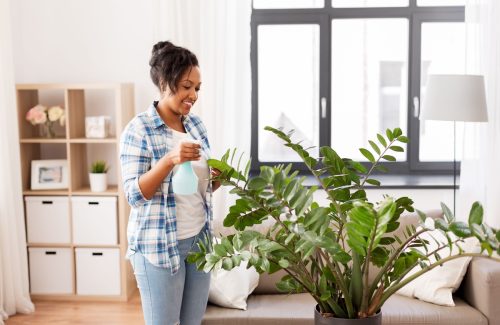
Root rot is a condition that happens when your plants have been overwatered and the roots are attacked by fungus or bacteria. Perhaps you thought the soil was dry from touching the top layer, or maybe your pot doesn’t have drainage holes. Whatever the case, once root rot sets in, it can cause yellow or brown leaves and even kill the plant entirely.
Erinn Witz, a garden expert and co-founder of Seeds and Spades, recommends giving it a dose of diluted hydrogen peroxide if you think your plant is struggling with root rot.
“Mix one tablespoon of three percent hydrogen peroxide with one cup of filtered water, and use the mixture to water your plant. Hydrogen peroxide breaks down in the soil, adding a boost of oxygen that can help kill off the harmful microbes that are attacking your plant’s roots,” she explains.
Witz says this hack can also be used on healthy plants to give them some extra oxygen. “In this case, use one teaspoon of three percent hydrogen peroxide to one cup of filtered water and use it to water your plant like a normal watering.”
While this won’t reverse the damage that’s already been done, it will prevent root rot from spreading. In addition to this hack, you’ll want to re-pot the plant with fresh soil and avoid overwatering it moving forward.
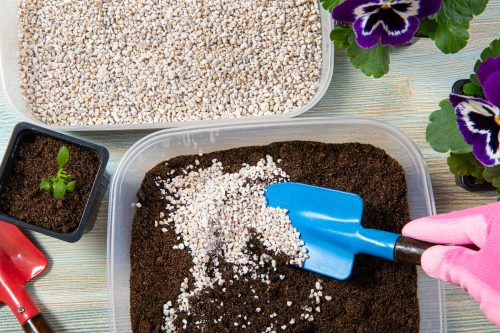
“Most potting mixes that we buy in stores retain too much water. As a result, the plants stay wet for too long, leading to root rot,” explains Vladan Nikolic, founder of the houseplant care blog Mr. Houseplant.
As a simple solution, Nikolic recommends mixing store-bought soil with perlite (an inexpensive mineral rock that can be found in bags at most gardening centers or even online from Amazon). The mix should be two parts soil, one part perlite. “It will not retain as much water and will contain more oxygen, which is crucial in reducing the chances of root rot,” he notes.
For a simple nutrient boost, Jen Stark, founder of the blog Happy DIY Home, suggests mixing coffee grounds with your soil. “Coffee grounds contain nitrogen, phosphorus, and potassium, which are essential nutrients for plants. Mix the grounds into your soil or sprinkle them around the plant’s base,” she says.
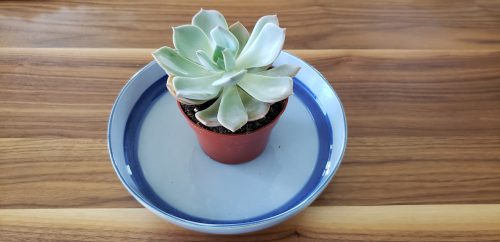
If you’re not sure how thirsty your plant is, you might want to “bottom water” it. Plant influencer @growwithjessie shared a video on TikTok about how she employed this hack with her planters that have drainage holes on the bottom.
Jessie simply filled a plastic Tupperware with water and sat her pots in it so the roots could soak up the liquid. “You know that there’s moisture reaching the bottom of your plants roots & this way, the roots in your potted plants can get stronger because they grow directly down towards the moisture,” she said.
She then used a spray bottle to spritz the top of the soil and the leaves, so they got some moisture, too.
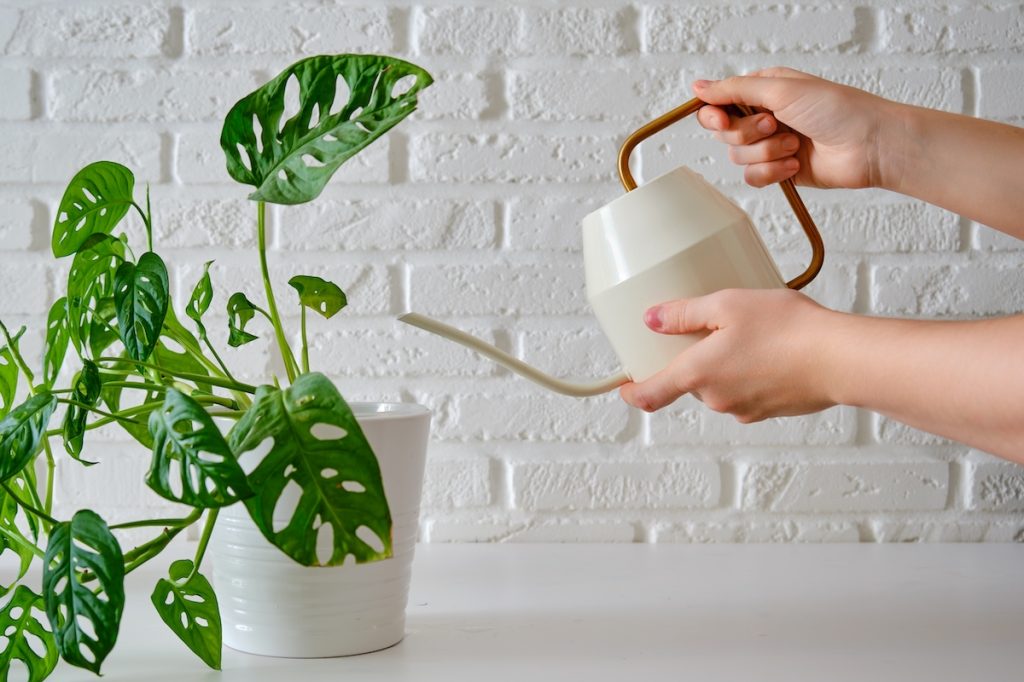
It’s easy to fall into autopilot mode with watering duties. However, this could be a serious mistake.
“The correct watering schedule for a specific plant can depend on many variable individual factors, such as temperature, the amount of light, pot size, humidity, or more,” says Vladan Nikolic, a houseplant care expert and founder of Mr. Houseplant. “For example, it might take three days for the top inch of the soil to dry out, and sometimes, it can take seven days, based on the environmental conditions.”
Instead of maintaining a strict watering schedule, switch to checking the soil moisture with a finger.
“You can also stick a chopstick or a bamboo stake into the soil and pull it out to see if there’s moist soil stuck on it,” he suggests. “This manual assessment is a simple and reliable method to ensure adequate watering.”
RELATED: 17 Easy Indoor Plants for Busy People.
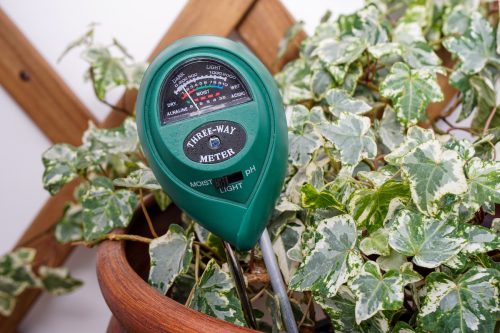
If you just can’t seem to get a handle on the whole watering thing, get yourself an inexpensive moisture meter, advises Lauren Caputo, founder and chief creative officer of PLNTD in Jersey City.
“While the top of your plant’s soil could look dry on top, and sure, sticking your finger in an inch or two might also feel dry, what about the rest of the soil you can’t reach?” says Caputo. This is where a moisture meter comes in: Simply place it in the soil, and it will immediately read whether the soil is dry, moist, or wet.
Rebecca Sears, the CMO and resident green thumb at Ferry-Morse, the longest-operating seed company in the U.S., also suggests a self-watering planter. These have built-in water meters to show you how much water your plant currently has.
“Once the water meter is filled, all you need to do is check in on it and refill when needed,” Sears says.
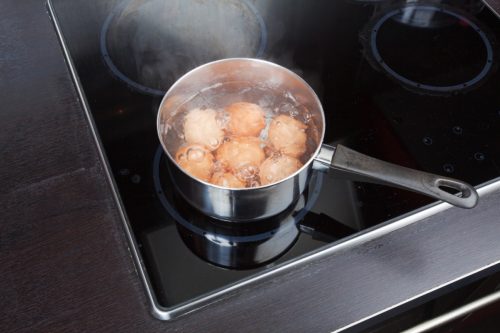
Making hard-boiled eggs for breakfast? Hang on to the water that’s left over in your pot and use it to water your plants.
“When you boil eggs, the calcium within the eggshells leaks into the water,” DIY Garden blogger Emma Loker previously explained to Best Life. “Eggshells are a rich source of calcium, a mineral that helps keep the soil pH between 6 and 6.5, the optimal conditions for plants to extract essential nutrients.”
Calcium strengthens plants’ cell walls, which helps them grow and stay healthy. You can also make an eggshell fertilizer by crushing or grinding the shells, according to Master Class. However, they note that “it can cause disease in geraniums, violets, azaleas, and other acid-loving plants.”
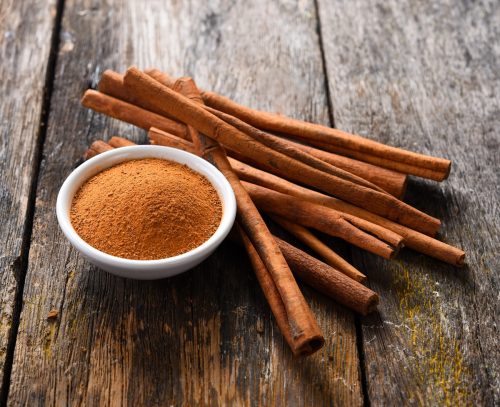
Another plant killer is “damping off,” a disease common in seedlings that occurs when fungus or mold begins to grow. As the University of Minnesota Extension explains, plants with mature leaves and root systems can usually fight off the fungus, but “young leaves, roots, and stems of newly emerged seedlings are highly susceptible to infection.”
A pathogen can enter your planter through potting soil, your garden tools, insects, or even your own hands. Since it’s so hard to detect, a simple way the pros prevent damping off is by sprinkling cinnamon on top of the plant’s soil.
Lindsey Hall, horticulturist and co-founder of Positive Bloom, previously told Best Life that the spice works by “killing the fungus and ensuring the healthy growth of seedlings.” As it turns out, cinnamon has anti-fungal properties. And a bonus: Many common insects and pests are repelled by its scent.
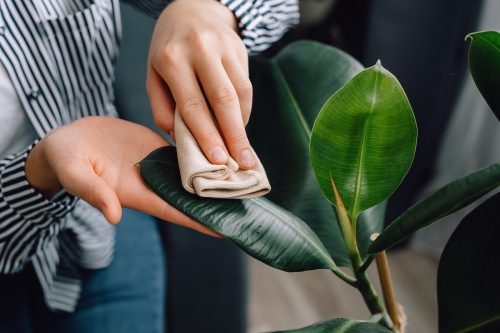
It’s a no-brainer that plants need sunlight, but according to Sears, dust on your plants can impact how much light they’re soaking up and, as a result, stunt their growth.
Therefore, Sears recommends giving your plant babies a weekly cleaning: “For plants with smooth leaves … you can give them a quick wash with room-temperature water or gently wipe away the dust with a cloth. If your plant has hairy leaves, grab a soft paintbrush to easily brush dust and other debris off.”
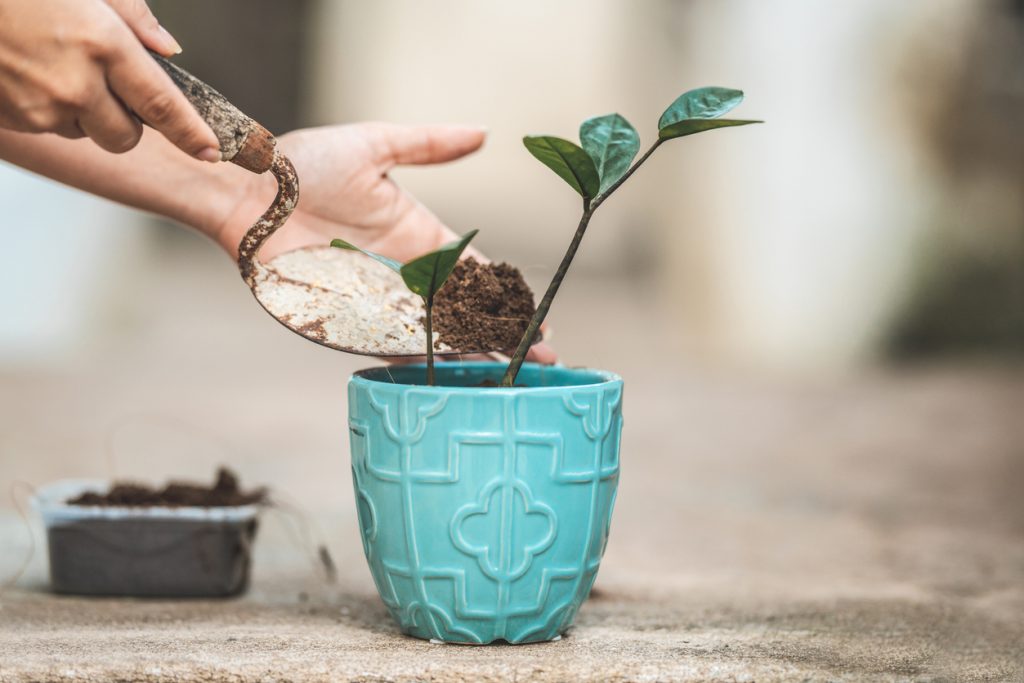
There’s an easy way to ensure you get on the right cycle of adding fertilizer to your potted plants.
“People often make the mistake of thinking that more fertilizer is always better. However, if the plant is dormant, it can’t absorb the extra nutrients,” says Nikolic. “These nutrients accumulate in the soil and can cause root burn.”
To prevent this, he says to fertilize the plant only when it’s actively growing, which means sprouting new leaves and growing wider or taller.
“This ensures that the plant will absorb the nutrients optimally and use them to support new, healthy growth,” he explains.
RELATED: The 5 Best Potted Plants for Your Front Porch, Gardening Experts Say.
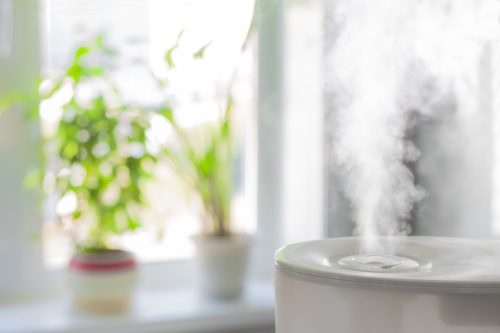
Many popular houseplants are native to tropical climates and prefer a humid environment. This list includes philodendrons, monsteras, and pothos plants, according to Jennifer Green, a botanist and writer at Positive Bloom. “Therefore, you should find a way to increase humidity levels,” she says, adding that a humidifier is an easy way to do this.
Alfred Palomares, vice president of merchandising at 1-800-Flowers.com, suggests a self-timed humidifier. “This will also help hydrate your plants on a set schedule, especially once you know how often they need to be watered,” he notes.
Palomares adds that humidifiers are especially helpful in the winter, when “heating systems are pulling moisture out of the air.” For this reason, Green also says to “keep your plant away from cold drafts, vents, and air conditioners, but also from heat sources such as radiators or fireplaces. Most plants don’t like sudden temperature changes, and can’t tolerate lower temperatures.”
You can also make a DIY humidity tray, as Stark explains. “Fill a shallow tray with pebbles, and then put your plant’s pot on top of the tray. Then fill the tray with water until it just touches the bottom of the pot—this will increase humidity around the plant. Refill it when needed to keep your plants happy!”
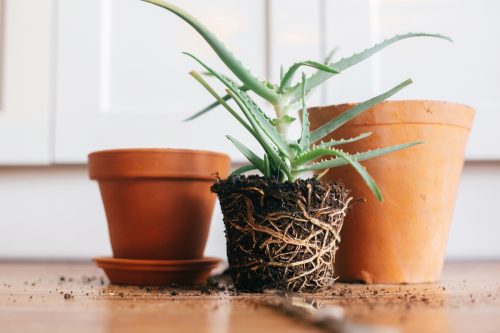
Sometimes all you need to do to revive a houseplant is re-pot it.
It’s common for plants to outgrow their pot, causing their roots to become cramped and tangled together—which makes it difficult for them to absorb the nutrients and the water that they need, explains Jeremy Yamaguchi, CEO of Lawn Love. “Repotting the plant into a larger pot will give the roots more room, and it will also help you see if there is any root rot,” he says.
It can sometimes also be an issue with the soil, too. “Over time, the soil in pots compacts, and the nutrients deplete much faster in a small amount of potting soil than in a big outdoor garden,” Nikolic tells Best Life. “Compact, dense soil hinders both water and nutrient uptake. Giving your plants fresh and aerated soil packed with all the essential nutrients keeps them happy and healthy.” He adds that that repotting also gives you an opportunity to to examine the roots and prune any dead or diseased tissue.
Conversely, sometimes your pot can be too large, according to Pat May, CEO and founder of the app Prōpa, which helps people share houseplant cuttings. “When a pot is too big, the plant is going to spend more of its energy growing roots instead of foliage,” May shares. “While your plant might be healthy, it won’t seem to grow … Furthermore, some species prefer to be root-bound. Finally, having a pot that’s too big can affect how water and fertilizer are distributed.”
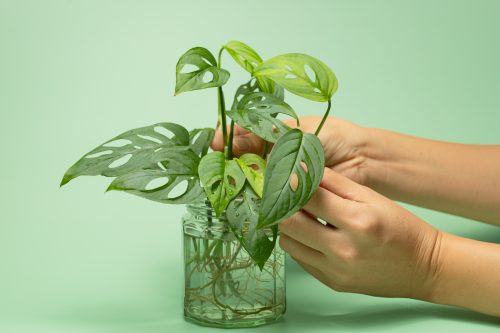
“If you feel that you’ve been doing everything right and your plant is still looking sad, it might be worth it to propagate the healthy parts of your plant and try to grow it again,” suggests Caputo.
“Depending on the type of plant, a stem cutting or a cut near a visible node is all you need,” she explains. “Once you have your cuttings, get them into fresh filtered water and place them in a bright space. Change the water about once a week. In a few weeks (if it was a healthy enough plant), you will start to see roots developing! Wait until the roots are at least three inches before repotting in soil and trying again!”
RELATED: The 4 Worst Houseplants If You Have Allergies.
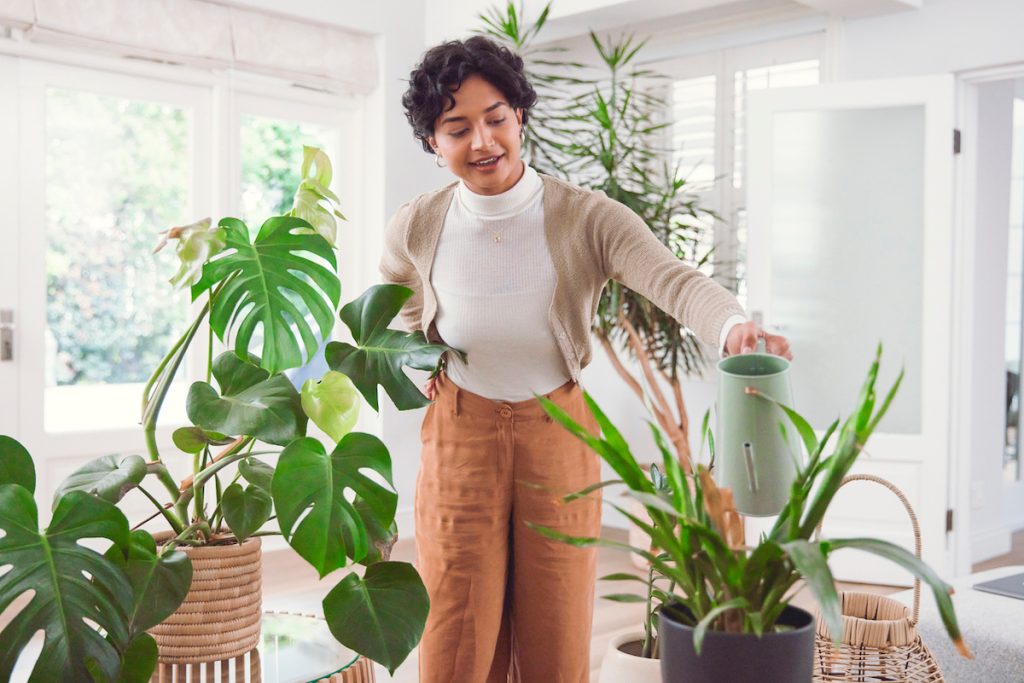
To set yourself up for success, consider your skill level and your space when you’re purchasing plants, instead of buying anything that catches your eye.
“Choose plants according to the level of care you’re willing and capable of providing,” Nikolic suggests. “If you’re a newbie, it’s a good idea to start with low-maintenance plants first. This will give you a self-confidence boost to improve your gardening skills and upgrade to finicky plants gradually.”
You should also think about how much space the mature plant needs and if you can provide it with enough light. “It’s easy to get carried away when buying plants, but careful planning prevents stress and potential problems along the road,” he adds.
